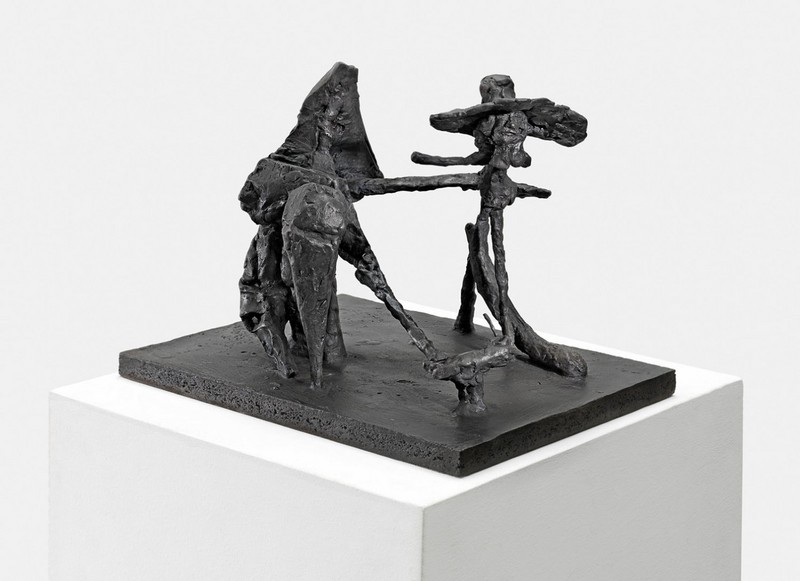Peter Stauss
07 Nov - 19 Dec 2015
PETER STAUSS
Die unsichtbare und die dritte Hand
7 November – 19 December 2015
carlier | gebauer is pleased to announce a solo exhibition with gallery artist Peter Stauss, opening Friday, 6 November from 6 - 9 pm.
For his third solo exhibition with the gallery, Stauss will present a series of large-scale oil paintings alongside related small-scale bronze sculptures.
The Invisible and the Third Hand focuses on a single character, who appears throughout the works on view in different permutations: the Dutch master. Although their significance may not seem immediately apparent, the legacy of Dutch master paintings weighs heavily on our present. Their depictions of the emergence of an inchoate capitalism begs comparison to our contemporary system of alienated labor, speculation, and futures dealing.
In Stauss‘ painterly investigations the Dutch master appears as a sign without a real body, reduced only to his hat. These expressively rendered, outsized accessories seem to dwarf those who wear them. In one painting, the brim of a tall green hat dramatically flips upward to reveal an earnest face that equally recalls a greyhound dog and a once-angular humanoid visage that has deflated like a balloon. A sinewy purple arm raises a large soda to the figure‘s concerned face while long, well-formed fingers proudly display a hamburger. At the bottom of the work, a distended foot seems ready to step out of the painting. This distorted body, which appears more like a superhero on a diet than something that could properly be described as human, seems to be wasting away while „nourishing“ itself with its hands and plotting escape with its feet.
The poppy, vibrant compositions in the exhibition signal a clear departure in style for Stauss. While earlier works depicted wild, animated scenes with multiple characters, the newer paintings fuse—or perhaps more accurately prise open—seemingly disparate body parts and objects into an individual figure with each component forming a constitutive element of the painting itself. A key reference point for the exhibition is Rembrandt‘s The Anatomy Lesson of Dr. Nicolaes Tulp (1632), which depicts one of the anatomy lessons that were common teaching opportunities and social events in the 17th century. The public autopsy of criminal cadavers posits the body as a site to be explored, which resonates with Stauss‘ investigation of the body as an open space—a notion influenced by the French philosopher Jean-Luc Nancy. As Nancy writes, “the body is that which gives rise to (but literally, gives space or gives room to) existence. The body is that which spaces space: ‘It is the very plasticity of expansion, of extension according to which existences take place.”
Peter Stauss (b. 1966, Germany) lives and works in Berlin. He has recently exhibited at Kunsthalle Marcel Duchamp, Switzerland; Helsinki Contemporary, Deichtorhallen, Hamburg; and Drawing Room, London.
Die unsichtbare und die dritte Hand
7 November – 19 December 2015
carlier | gebauer is pleased to announce a solo exhibition with gallery artist Peter Stauss, opening Friday, 6 November from 6 - 9 pm.
For his third solo exhibition with the gallery, Stauss will present a series of large-scale oil paintings alongside related small-scale bronze sculptures.
The Invisible and the Third Hand focuses on a single character, who appears throughout the works on view in different permutations: the Dutch master. Although their significance may not seem immediately apparent, the legacy of Dutch master paintings weighs heavily on our present. Their depictions of the emergence of an inchoate capitalism begs comparison to our contemporary system of alienated labor, speculation, and futures dealing.
In Stauss‘ painterly investigations the Dutch master appears as a sign without a real body, reduced only to his hat. These expressively rendered, outsized accessories seem to dwarf those who wear them. In one painting, the brim of a tall green hat dramatically flips upward to reveal an earnest face that equally recalls a greyhound dog and a once-angular humanoid visage that has deflated like a balloon. A sinewy purple arm raises a large soda to the figure‘s concerned face while long, well-formed fingers proudly display a hamburger. At the bottom of the work, a distended foot seems ready to step out of the painting. This distorted body, which appears more like a superhero on a diet than something that could properly be described as human, seems to be wasting away while „nourishing“ itself with its hands and plotting escape with its feet.
The poppy, vibrant compositions in the exhibition signal a clear departure in style for Stauss. While earlier works depicted wild, animated scenes with multiple characters, the newer paintings fuse—or perhaps more accurately prise open—seemingly disparate body parts and objects into an individual figure with each component forming a constitutive element of the painting itself. A key reference point for the exhibition is Rembrandt‘s The Anatomy Lesson of Dr. Nicolaes Tulp (1632), which depicts one of the anatomy lessons that were common teaching opportunities and social events in the 17th century. The public autopsy of criminal cadavers posits the body as a site to be explored, which resonates with Stauss‘ investigation of the body as an open space—a notion influenced by the French philosopher Jean-Luc Nancy. As Nancy writes, “the body is that which gives rise to (but literally, gives space or gives room to) existence. The body is that which spaces space: ‘It is the very plasticity of expansion, of extension according to which existences take place.”
Peter Stauss (b. 1966, Germany) lives and works in Berlin. He has recently exhibited at Kunsthalle Marcel Duchamp, Switzerland; Helsinki Contemporary, Deichtorhallen, Hamburg; and Drawing Room, London.

